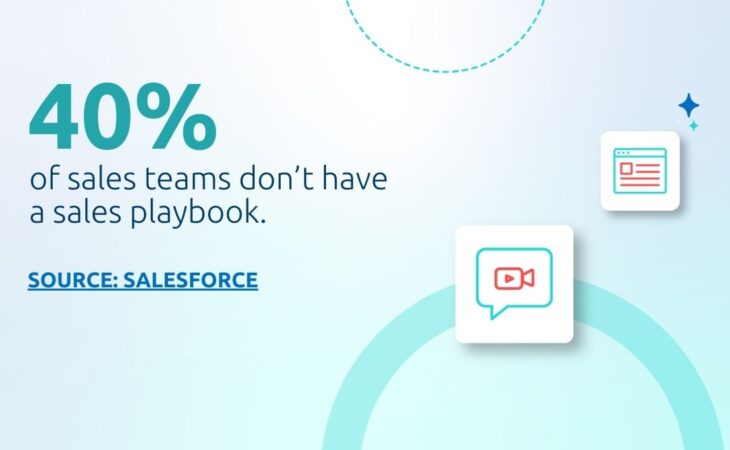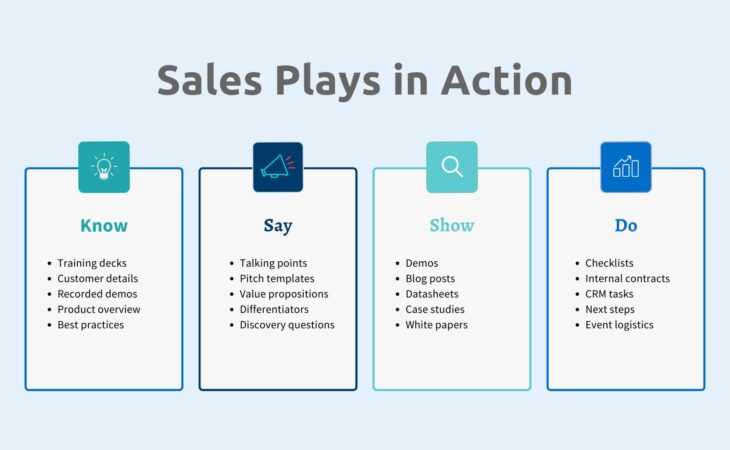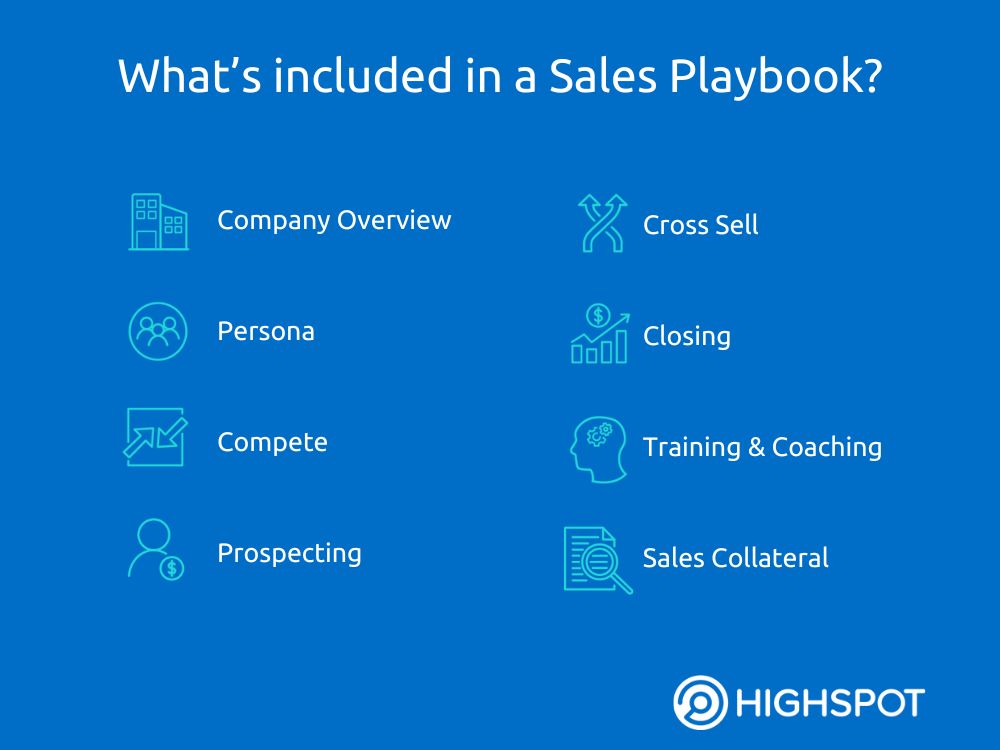What if there was a way to increase the likelihood that your sales reps will meet their quota. It may sound like a gimmick, but there really is a way to ensure your reps are performing at the highest level while meeting or exceeding quota. Enter sales playbooks.
Not surprisingly, 42% of best-in-class companies use sales playbooks which result in better quota attainment, higher customer retention rates, and higher lead conversion rates. What is surprising, is that 40% of sales teams don’t use a sales playbook.

So why isn’t every company tapping into the power of playbooks?
According to a survey by DSG, the top reasons why companies don’t use them is because they don’t have the bandwidth or don’t have a platform to house material and easily distribute it to salespeople.
That said, if you’re looking to build a sales team full of superstars, it might be time to consider adding a sales playbook to your repertoire. Luckily, this blog can help you create an effective playbook that boosts productivity and drives revenue growth.
- What is a Sales Playbook?
- Why are Sales Playbooks Important?
- What is included in a Sales Playbook?
- The Top 3 Sales Playbooks Every Team Needs
- 7 Steps to Create the Perfect Sales Playbook
- Sales Playbook Best Practices
- Boost Sales Performance with Sales Playbooks
What is a Sales Playbook?
Simply put, a sales playbook is a comprehensive way of documenting and detailing all the strategies, best practices, and techniques a sales team needs to win and retain customers. It’s essentially your handbook that details the whole selling process. The most effective sales playbooks should guide reps for any given scenario across sales cycles, industry factors, specific buyer journeys, and unique pain-points of consumers. Playbooks help guide reps by including all sales plays and crucial documents like sales scripts and buyer personas all in one place.
What is a Sales Play?
A sales play refers to a set of repeatable steps, actions, and best practices for sales reps to use during a specific selling scenario. It gives reps everything they need to know, say, show, and do during any customer interaction, no matter where they are in the sales cycle.
A sales playbook is a collection of many different sales plays. Sales plays can be created to support different regions, product lines, or buyer personas; this ensures that your reps’ tactics match different customer needs. Sales play content should provide context around what you are asking sellers to do, how to take that specific action, and inform sales managers how to coach against that action.

Download Now: Sales Play Checklist: Turn Strategy into Action
Why are Sales Playbooks Important?
Sales playbooks are vital for your sales team’s success for a number of reasons. For example, a sales playbook can help you unify your sales team, save your team time, make it easy to hire and train new sales reps, and even help simplify the process of launching new products. Here are three benefits of playbooks:
- Creates alignment across the sales team: By housing all content, strategies, training, and best practices within a sales playbook, every rep has access to the right messaging, outreach strategies, discovery questions, objection-handling techniques, and more, creating a unified buying experience for every customer.
- Turns low performers into top performers: By leveraging playbooks, sales leaders can add sales call recordings and best practices from top performers into your sales plays so all team members know exactly what to do when it comes to closing deals.
- Creates training, onboarding, and coaching opportunities: By utilizing playbooks, you can package all training, coaching, and onboarding processes into one place, empowering new hires at every level while encouraging new behaviors that allow reps to effectively engage buyers at any stage in the sales cycle.
What is included in a Sales Playbook?
A sales playbook should consist of any materials that help your sellers sell. It should contain all of your sales plays that support specific scenarios and guide reps through any customer conversation, at any stage of the sales funnel.

A good rule of thumb is to make sure the following are included in your playbook:
- Company Overview: Include company strategy, mission and values, roles and responsibilities to define who is accountable for what
- Persona: Tailored to your ideal customer profile and specific buyer personas
- Compete: How to handle common objections and recommended objection handling skills to land competitive differentiation
- Prospecting: Recommended inbound and outbound discovery questions and elevator pitches
- Demo: Details demo best practices for different buyer personas and tips for handling Q&A sessions
- Product: Details on a specific product line like price points, use cases, case studies, core value offerings
- Region/Territory: Supports regional activities, such as field events
- Closing: Guides sellers on how to close deals, including working with intra-company functions like legal and deal desk
- Post Sales: Details post-sale handoffs and follow-ups and step-by-step CRM instructions
- Renewal/Cross-Sell/Up-Sell: Supports post-sale motions, with updated messaging for existing customers
- Customer Win-Back: Addresses reasons for customer attrition and implement strategies to re-engage lapsed customers through incentives or promotions
- Training, Coaching, Onboarding Materials: Gives sellers additional training and coaching to get new salespeople and experienced reps up to speed on new initiatives
- Sales Collateral: Sales reps need to be able to quickly provide personalized sales collateral to buyers and access all relevant material
- Sales Technology: Guidance on using sales tools and integrations for efficient workflows and enhanced customer experience
Download our sales playbook guide to land the modern sales playbook format.
The Top 3 Sales Playbooks Every Team Needs
If you’re wondering how to get started with playbooks, we’ve put together the three most common types of go-to-market initiatives that are run through sales playbooks.
Playbook #1: Product Launches
A product launch playbook is a strategic and tactical guide that outlines the key steps, activities, and resources needed to successfully bring a new product to market. It serves as a blueprint for product marketers and cross-functional teams to ensure that every aspect of the launch is well-planned, executed, and measured. This playbook should include key sales plays such as defining the audience, product messaging, and sales scripts.
Key metric to measure success:
- Revenue from sales opportunities that include the new product through new logos or cross-sell
Playbook #2: Compete
The recent Competitive Enablement Report found that 79 percent of internal stakeholders conduct their own research outside of the competitive intelligence function because intel is often hard to find. This can create inconsistencies in how your sales reps pitch the product or service.
A compete playbook will provide one location for sellers to access all of the knowledge and context they need to navigate challenging competitive situations. Providing this information in one place alongside related context and training ensures that reps are confident and knowledgeable when dealing with buyers.
Key metrics to measure success:
- Win rate against top competitors
- Decreased customer churn rates
- Increased deal velocity
Playbook #3: Engaging a New Buyer Role
Over the last decade, the expansion of buying committees has increased B2B deal cycles. Sellers frequently need to win over a dozen or more people to close the deal.
Targeting an important new buyer role allows sellers to multi-thread with a variety of contacts, increasing their chances of engaging a prospect account. Within this playbook, you’ll need various sales plays that provide reps with everything they need to know to engage the new buyer role and ultimately win them over. To effectively assist sellers, the play will need to include context about everything from pain points to appropriate terminology.
Key metrics to measure success:
- Pipeline and revenue from opportunities that include the new buyer role within the buying committee
- Marketing qualified leads (MQLs) and sales qualified leads (SQLs) from new buyer role
7 steps to craft the perfect sales playbook
Ready to build a sales playbook that’s sure to set reps up for success? Follow these seven steps to get started.
1. Align your go-to-market teams
Before you even begin to write down best practices, you must first understand what it is that you are trying to achieve. Most businesses have an idea of their sales strategy and key performance indicators (KPIs) such as “hit X-million in revenue” or “enter a new market”. However, when it comes to creating sales playbooks, you’ll need to be more specific about how you intend to achieve that.
You want to include a framework for helping both your sales and marketing teams align to identify, target, and convert qualified leads to achieve targeted goals. If your goal is to sell a new product line, then your initiatives should be based on sales content, marketing needs, and new behaviors and skills sales teams need to successful in the field.
2. Speak to your sales reps
It is essential that you involve sales reps in the process of developing your sales playbook. After all, their success rests on the value of the playbook’s content. Great enablement teams should regularly source and incorporate seller perspectives into their work.
For instance, at the start of any playbook, play, or kit development, ask reps for insight into where they are struggling. Perhaps they are missing a piece of content or maybe messaging isn’t resonating with customers. Let their perspective guide how you think about the initiatives, train new hires, and evolve your sales playbook. You can achieve this formally through advisory groups or surveys.
3. Use a sales methodology
Sales methodologies are integral to creating a sales playbook. That is because your sales methodology typically prescribes an overall approach to selling – from your messaging to your sales process.
If you don’t already have a sales methodology, it’s time to select one. To do so, think about the type of product you sell and the type of customer you sell to. Whether you’re an innovative startup looking to break through the status quo or an industry giant selling complex solutions, who you sell to and what you sell will determine the best methodology for your business.
If you have a sales methodology in place, consider integrating it into your sales enablement platform. Modern platforms offer marketplaces that allow you to install your chosen methodology. This ensures that reps only ever have to access one solution – your sales enablement platform – to find the guidance, training, and content they need. It also means it will be easier than ever to integrate methodology content into your sales playbook.
4. Create a detailed outline of the sales process
While some sales reps may grasp the basics, it’s common to forget the next steps in the midst of the sales process. This is a great opportunity to weave in your sales messaging to guide them from start to finish. Use scripts from emails, pitches, and other outreach materials to ensure consistency.
5. Develop sales playbook, play, and kit content and training
Once you have a clear idea of what you are going to do, it’s time to make it real by developing content, existing and new rep training, and coaching materials to support your initiative. A word of caution, however: Often, organizations feel that new things demand new everything. But doing more isn’t necessarily a viable path to developing effective playbooks. Instead, it can have the effect of overwhelming reps.
Rather, start this process by auditing what you have. A heatmap analysis of your current content can reveal which of your sales assets are performing well and which aren’t. Likewise, in-platform dashboard reporting from your enablement solution can deliver similar insights for your training materials. Use this data to inform your own best practices on which formats, messaging, and tactics are currently working. From there, invest wisely to develop resources that put quality over quantity.
6. Socialize your sales playbook
Landing your sales playbook with your sales organization requires buy-in from the entire team – your sales leaders and subject matter experts all the way down to your field reps. If you followed the steps outlined above, your sales organization should have been included in some of the development processes and will have an idea of what’s going on. Still, you want to launch the final product strategically to ensure adoption in the long run.
Prepare to take your playbook on a roadshow of sorts – start by announcing changes through top-level leadership. Leaders should communicate why it matters and what’s in it for reps. You should meet with managers to walk them through changes, and train them on how to coach against new behaviors. Finally, use your tech stack to reinforce your message by surfacing your new playbook front and center in your enablement platform.
7. Measure the impact and optimize your efforts
Sales playbooks act as living, breathing documents that are updated routinely as new information is collected. To measure the impact, you’ll want to review:
- Volume metrics = These can speak to adoption: How many people have viewed the sales playbook? How long have they spent looking at it? Which content asset is being used the most?
- Sales impact and effectiveness metrics = These demonstrate mastery of a new behavior: Watching recorded videos of discovery calls or role-playing sessions.
Armed with a modern sales analytics platform, sales managers can leave comments for reps, based on what they’re hearing from buyers, allowing teams to improve content in the playbook in near real time.
Sales Playbook Best Practices
As you build out your sales playbook, keep these best practices in mind to maximize effectiveness.
Measure Playbook Impact
Good sales playbooks have the most organizational impact when they are focused on growing the business. You need leading and trailing indicators around a playbook to measure the impact. Examples include the number of deals, size of deals, and the speed with which deals move through the pipeline. As you make improvements to those indicators, that’s when your organization can realize impact.
Collaborate with Other Teams to Create Playbooks
Companies that figure out cross-functional alignment drive change, so it’s important to get buy-in across leadership, multiple levels, and departments. Get input from sales leaders, executives, marketing, customer success, and sales enablement. Whoever is creating the playbook should get together quarterly to review its adoption and success metrics. They should decide what updates are needed and what new playbooks should be created.
Abandon Static Playbooks in Favor of Dynamic Playbooks
There are multiple options for creating and deploying a playbook. The first is static, which consists of PDFs, Word docs, PowerPoints, and more. A dynamic playbook, on the other hand, use various tools such as a sales enablement platform, sales playbook software, and CRM.
A recent study outlines that high-performing organizations are 48% more likely to use dynamic playbooks. The reason being that dynamic playbooks can provide benefits including easier playbook creation, easier updating, and analytics to measure the effectiveness of playbook content. Users of static playbooks are most likely to never update playbook content. Your sales team will not perceive your playbook as valuable when it’s outdated, hard to find the information they need, and are forced to scroll endlessly. Plus, it’s difficult or nearly impossible to measure the effectiveness of static playbooks.
Incorporate Best Practices from Top Performers
A playbook is the place to package all the best ideas in one location. Use a playbook to bottle up the words, questions, and stories of your best sellers, and replicate those best practices across the team. Your organization may be moving too fast and hasn’t taken the time to identify best practices. The playbook creation process should force you to identify top performers and bring them together on a core team. Use that team when creating videos, validating talk tracks, and sharing success stories.
Utilize Video to Your Advantage
High-performing organizations are 38% more likely to use video content in playbooks. Studies show that when we consume information by video, we retain an astounding 95% of it. By contrast, we only retain 10% by reading text on a page.
Create Detailed Talk Tracks
If you’re trying to transition from generic to persona specific sales conversations, talk tracks (i.e. insights, discovery questions, proof points, objection handling) give reps the ability to tailor conversations to a specific persona. Don’t overlook this type of practical resource for sales. Beyond providing product knowledge, a talk track is the sales-ready type of content your playbook should include.
Boost Sales Performance with Highspot’s Sales Playbooks
Whether you’re just getting started out with sales playbooks or are in need of a more robust solution, Highspot offers the most complete sales playbook software.
With Highspot, enablement and sales teams can quickly build sales playbooks, bundling insights, messaging, value propositions, and training into one on-demand resource for sales managers and reps. With real-time data on play usage, you’ll be able to continuously optimize programming, improve execution, and drive action—increasing sales velocity and win rates.
Book a demo today!


